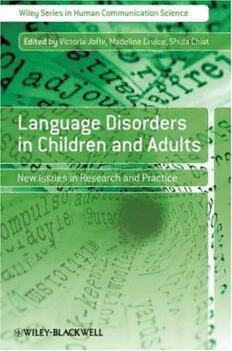
Language Disorders in Children and Adults: New Issues in Research and Practice (Wiley Series in Human Communication Science) PDF
Preview Language Disorders in Children and Adults: New Issues in Research and Practice (Wiley Series in Human Communication Science)
Language Disorders in Children and Adults New Issues in Research and Practice Edited by Victoria Joffe Madeline Cruice and Shula Chiat A John Wiley & Sons, Ltd., Publication http://avaxhome.ws/blogs/ChrisRedfield Language Disorders in Children and Adults New Issues in Research and Practice Language Disorders in Children and Adults New Issues in Research and Practice Edited by Victoria Joffe Madeline Cruice and Shula Chiat A John Wiley & Sons, Ltd., Publication This edition fi rst published 2008 © 2008 John Wiley & Sons Wiley-Blackwell is an imprint of John Wiley & Sons, formed by the merger of Wiley’s global Scientifi c, Technical and Medical business with Blackwell Publishing. Registered offi ce John Wiley & Sons Ltd, The Atrium, Southern Gate, Chichester, West Sussex, PO19 8SQ, United Kingdom Editorial offi ce John Wiley & Sons Ltd, The Atrium, Southern Gate, Chichester, West Sussex, PO19 8SQ, United Kingdom For details of our global editorial offi ces, for customer services and for information about how to apply for permission to reuse the copyright material in this book please see our website at www.wiley.com/wiley-blackwell. The right of the author to be identifi ed as the author of this work has been asserted in accordance with the Copyright, Designs and Patents Act 1988. All rights reserved. No part of this publication may be reproduced, stored in a retrieval system, or transmitted, in any form or by any means, electronic, mechani- cal, photocopying, recording or otherwise, except as permitted by the UK Copyright, Designs and Patents Act 1988, without the prior permission of the publisher. Wiley also publishes its books in a variety of electronic formats. Some content that appears in print may not be available in electronic books. Designations used by companies to distinguish their products are often claimed as trademarks. All brand names and product names used in this book are trade names, service marks, trademarks or registered trademarks of their respective owners. The publisher is not associated with any product or vendor mentioned in this book. This publication is designed to provide accurate and authoritative information in regard to the subject matter covered. It is sold on the understanding that the publisher is not engaged in rendering professional services. If professional advice or other expert assistance is required, the services of a competent professional should be sought. Library of Congress Cataloging-in-Publication Data is available A catalogue record for this book is available from the British Library. ISBN 978-0-470-51839-7 Set in 10/12.5pt Garamond by SNP Best-set Typesetter Ltd., Hong Kong Printed in Singapore by Markono Print Media Pte Ltd 1 2008 Contents Preface vii Introduction Language disorders in children and adults: current themes, issues and connections Victoria Joffe, Madeline Cruice and Shula Chiat xi Chapter 1 Beyond outcomes: the importance of developmental pathways 1 Penny Roy and Shula Chiat Chapter 2 Substance or scaffold? The role of language in thought 20 Rosemary Varley Chapter 3 Aphasia therapy and Cognitive Neuropsychology: a promise still to be fulfi lled? 39 Jane Marshall Chapter 4 Speech-language therapy and evidence-based practice 54 Barbara Dodd Chapter 5 Minding the gap between research and practice in developmental language disorders 68 Victoria Joffe Chapter 6 Comparing and contrasting views: building consensus around quality of life with aphasia 98 Madeline Cruice, Ruth Hill, Linda Worrall and Louise Hickson v vi Contents Chapter 7 Autism and specifi c language impairment: a tantalizing dance 122 Michael Rutter Chapter 8 Outcomes for young people with a history of specifi c language impairment at 16–17 years: a more positive picture? 138 Geoff Lindsay and Julie Dockrell Chapter 9 Making new connections – where to next? 159 James Law Index 176 Preface ABIGAIL BEVERLY (1983–) Abigail has a speech and language disorder and experiences diffi culties with the understanding and expression of language and communication. She has problems understanding complex language and also in using language to organize and express her ideas, particularly in written form. Her diffi culties have affected many aspects of her life and meant that she has to fi nd different ways to convey her thoughts, feelings and ideas to others. Problems with ‘words’ have changed how she looks at the world and make sense of it. This has infl uenced and informed her artwork. In December 2005, Abigail was granted the Sir Sigmund Sternberg Award from the charity Afasic to mount an exhibition of work inspired by her experience of growing up with a speech and language disorder. The exhibition, Making Sense of the Puzzle, was the outcome of that award. Abigail has also obtained a distinction for her thesis ‘How Do We Under- stand Words?’ produced for her degree in Textile Design at the Central Saint Martin’s College of Art and Design. The following is an account of the diffi culties she experiences, in her own words: Words ‘get everywhere’. When doing simple, everyday things like shopping, using the Internet, asking directions, we are required to assimilate and respond to words all the time. For those without diffi culties it is probably hard to imagine what it is like if you cannot understand the words. Until I was coming up to fi ve years old, words went over my head. Then, it was suggested to my parents that they make a little book of photographs for me, showing my daily routine, actions I was very familiar with. As we read the sentences describing the pictures day after day, I came to understand the words by linking them to the actions shown in the pictures. I started to become familiar with related words and sounds for each routine. I still have problems understanding complex language and also in using language to express my ideas. This has affected many aspects of my life and vii
